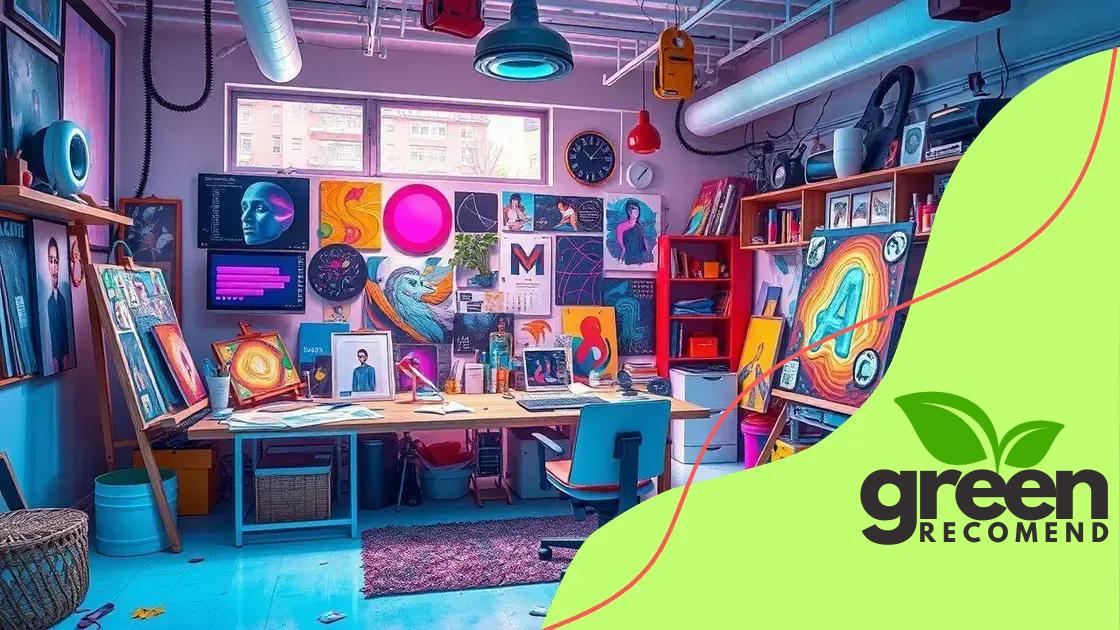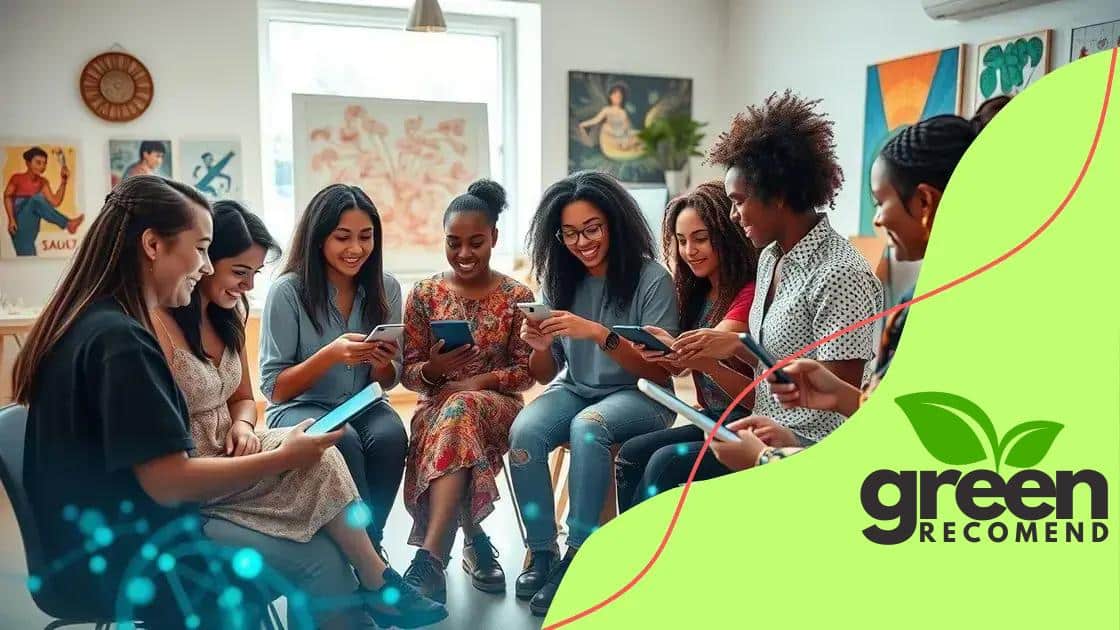The role of AI in transforming the creative industries

The role of AI in transforming the creative industries includes enhancing collaboration, personalizing artistic experiences, and driving innovation across music, visual arts, and film, reshaping how artists create and engage with their audiences.
The role of AI in transforming the creative industries is becoming increasingly significant as artists explore new possibilities. Curious about how these technologies are reshaping creativity? Let’s dive in to uncover the fascinating intersection of AI and art.
Understanding AI’s impact on creativity
Understanding AI’s impact on creativity is crucial as we witness its integration into various artistic endeavors. From music to visual arts, AI is changing how we create and experience art.
How AI Influences Creative Processes
AI tools assist artists in exploring new ideas and techniques. By analyzing vast amounts of data, these tools can offer suggestions and enhancements that inspire artists. This interaction between human creativity and AI opens up exciting avenues.
Benefits of AI in Creativity
- Enhances artistic collaboration by providing new perspectives.
- Automates repetitive tasks, allowing artists to focus on their creativity.
- Introduces innovative techniques that evolve traditional art forms.
The relationship between AI and creativity also allows artists to push boundaries. Imagine a painter using AI to generate unique textures or a musician composing with the help of algorithms. These collaborations can lead to fresh styles that resonate with audiences.
Examples of AI in Creative Fields
Many creatives are already embracing AI’s potential. For instance, musicians are using AI to compose entire pieces of music, experimenting with different genres instantly. Visual artists are generating stunning visuals using AI algorithms that analyze existing artwork.
Moreover, filmmakers are utilizing AI to enhance scripts and predict audience reactions, improving the storytelling process. As AI develops, the possibilities for creativity continue to expand.
It’s essential to recognize that while AI can enhance the creative process, it does not replace the human touch. The essence of creativity remains in the artist’s vision. Thus, AI serves as a valuable tool that complements and enriches artistic expression.
Innovative tools shaping the creative process
Innovative tools are shaping the creative process in remarkable ways. These tools enhance creativity by providing artists with new techniques and resources to explore.
Types of Innovative Tools
There are various types of tools that artists can use to elevate their work. Whether it’s software for graphic design or apps for music composition, each tool has its unique strengths.
- Graphic Design Software: Programs like Adobe Creative Suite help designers bring their ideas to life.
- Music Composition Apps: Tools like Ableton Live allow musicians to experiment with sound in innovative ways.
- 3D Modeling Software: Programs like Blender enable artists to create detailed 3D art.
Innovative tools also foster collaboration among artists. With online platforms, creatives can share their work and receive feedback from others. This shared engagement can inspire new ideas and perspectives.
AI-Driven Applications
AI-driven applications are at the forefront of innovation. These applications analyze user input and suggest artistic enhancements. For example, AI can help in color selection for a painting or even generate unique music compositions based on user preferences.
As these tools develop, they become more accessible to everyone. Artists of all skill levels can take advantage of these resources to enhance their creative output. The ease of use encourages experimentation, leading to further innovation.
By integrating these advanced tools into their workflows, artists can save time and enhance their artistic expression. The creative process becomes more efficient, allowing for quicker iterations and new explorations of ideas.
How AI enhances collaboration in art

AI enhances collaboration in art by bringing together artists from different backgrounds and disciplines. This technology fosters a unique environment where creativity can thrive.
Connecting Artists Globally
With the rise of digital platforms, artists can collaborate regardless of their physical location. AI tools make it easy for creators to share ideas and feedback in real-time. This connection leads to richer artistic experiences and influences.
- Online Collaboration Platforms: Websites like ArtStation allow artists to showcase their work and seek collaboration.
- AI-Powered Feedback Tools: Tools that offer instant feedback help artists improve their projects through shared input.
- Virtual Workshops: Artists can participate in virtual workshops that utilize AI to facilitate interactive learning.
When artists work together using AI, they tap into each other’s strengths. This collaborative spirit drives innovation, resulting in unique fusion art forms that blend styles and techniques.
Enhancing Communication
AI enhances communication between collaborators by offering translation services and simplifying information sharing. Artists can focus on their work rather than overcoming language barriers or misunderstandings.
This ease of communication allows for more meaningful dialogues around artistic concepts. Artists can exchange ideas more freely, fostering greater creativity. For instance, an illustrator can work with a musician to produce a piece that tells a story through both visual and auditory means.
As technology advances, AI will continue to play a role in enhancing collaboration. It provides tools that allow artists to experiment together, pushing the boundaries of creativity further than ever before.
Case studies of AI in the creative sector
Case studies of AI in the creative sector illustrate how technology can drive artistic innovation. These examples reveal the extensive impact AI has on various disciplines.
Music Industry
In the music industry, AI tools are transforming how songs are created. For instance, platforms like OpenAI’s MuseNet can compose music across different genres. Musicians use these tools to spark creativity and generate unique pieces that resonate with audiences.
- Collaboration with AI: Artists blend their styles with AI-generated compositions.
- Creating Remixes: AI tools assist in remixing existing tracks, giving them a fresh sound.
- Music Distribution: AI analyzes listener data to promote songs effectively.
This involvement of AI enables artists to explore new musical frontiers. Through real-time feedback and analysis, musicians can fine-tune their work to meet audience preferences.
Visual Arts
In visual arts, AI has also made significant strides. Tools like DeepArt and DALL-E create art based on specific styles or concepts, allowing artists to experiment with visuals. These applications use deep learning to generate images that blend creativity with technology.
Artists have used these tools to reimagine classic artworks or develop new creations that challenge traditional boundaries. With AI, the visual arts become a playground of possibilities, where artists can push their skills further.
Film and Photography
The film industry has embraced AI for script analysis and editing. AI algorithms can predict successful plot elements, helping writers craft engaging stories. In photography, AI helps in editing photos by enhancing images automatically, allowing photographers to focus on their artistic vision.
By analyzing large datasets, AI generates insights that shape narratives and visual styles. These case studies demonstrate AI’s role as both a tool and a collaborator in the creative process.
Future trends of AI in creative industries
Future trends of AI in creative industries point to a transformative landscape where technology and artistry blend seamlessly. As AI continues to evolve, its role in creativity will only expand.
Personalized Art Experiences
One significant trend is the rise of personalized art experiences. With AI, companies can analyze user preferences to deliver tailored content. This personalization enhances engagement and makes art accessible to a wider audience.
- Customized Music Playlists: AI can create playlists based on listeners’ moods and historical preferences.
- Interactive Digital Art: Artists can design interactive experiences that change based on viewer interaction.
- Tailored Literature Recommendations: AI can suggest books or stories based on reading habits.
These innovations will allow for more meaningful connections between creators and audiences. As a result, the relationship between art and consumer will deepen significantly.
A New Era of Collaboration
Collaboration will also evolve, with AI driving partnerships across various creative sectors. Artists will collaborate with AI tools to push the boundaries of their mediums. This collaboration will create new forms of art that are currently unimaginable.
For instance, filmmakers may work with AI to create scripts that analyze popular trends in storytelling, thereby increasing the chances of successful projects. Additionally, artists might blend digital and physical mediums through AI-enhanced installations, creating immersive experiences.
AI Ethics and Creativity
As AI’s influence grows, discussions about ethics in creativity will become more prevalent. Questions about ownership, authenticity, and the role of human creativity in an AI-driven world will challenge artists and technologists alike. The need for clear guidelines and ethical practices will shape the future of how AI is integrated into creative workflows.
With the rapid advancements in AI, staying updated on these trends is essential for creators. Embracing AI can lead to innovative solutions, fresh ideas, and a vibrant creative future.
FAQ – Frequently Asked Questions about AI in Creative Industries
How is AI changing the creative process for artists?
AI enhances the creative process by providing tools that help artists explore new ideas, improve collaboration, and personalize their work for audiences.
What are some examples of AI applications in music?
AI applications in music include composing assistance, remixing tracks, and generating personalized playlists based on listener preferences.
In what ways does AI contribute to visual arts?
In visual arts, AI tools can generate new artworks, assist in design, and enhance creativity by suggesting style combinations or modifications.
What ethical considerations arise with the use of AI in creativity?
Ethical considerations include questions of authorship, the authenticity of AI-generated art, and the potential impact on traditional artistic jobs.





